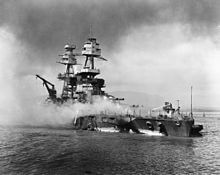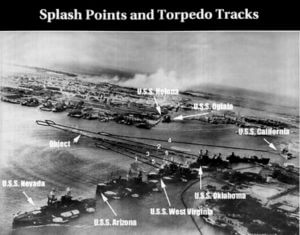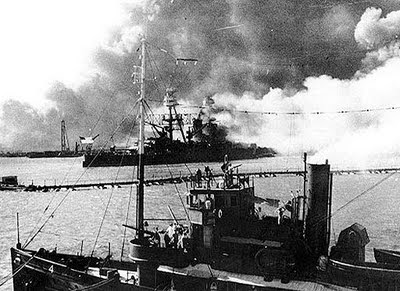Ricochet is the best place on the internet to discuss the issues of the day, either through commenting on posts or writing your own for our active and dynamic community in a fully moderated environment. In addition, the Ricochet Audio Network offers over 50 original podcasts with new episodes released every day.
 The Captain of the Nevada: Dec. 7, 1941
The Captain of the Nevada: Dec. 7, 1941

USS Nevada, beached and burning at Hospital Point
Author’s Note: I read “Day of Infamy” by Walter Lord when I was 11 years old. It is still the best first-hand account of the attack on Pearl Harbor. A great read you won’t be able to put down.
At 8 am on Sunday, Dec. 7, 1941, the 183 Japanese planes of the first attack wave descended on Pearl Harbor. Admiral Nagumo’s attack fleet was less than 100 miles from Pearl. Luckily the Enterprise, the huge American aircraft carrier, was at sea. Not so lucky was the fact that the American battleship fleet was anchored and inert, tied up in a neat row called Battleship Row in Pearl Harbor. The battleships were huge sitting targets. Even if someone had sounded an alarm when the planes were spotted on radar, it wouldn’t have made that much difference as it takes two hours for a battleship’s boilers to come up to full pressure so she can move properly. All of the battleships at Pearl had dead cold boilers that morning. Completely tied up at anchor, after coming up to full boiler pressure, it would have taken another 45 minutes with the help of multiple tugboats to get a battleship away from Battleship Row and moving.

Battleship Row under attack, Dec. 7, 1941.
It was Sunday morning and almost everyone was at Sunday morning services. However, to this fact and everything I stated in the preceding paragraph, there was one exception. The Battleship USS Nevada had about one-third of her crew and one officer and one quartermaster aboard. The boilers of the Nevada were at about half pressure. She was making repairs, even on Sunday morning.
The Japanese planes of the first attack wave descended without any warning whatsoever. Seeing the sitting ducks on Battleship Row, the pilots converged instantly for the attack on the American ships.
The Nevada was the last ship on Battleship Row in position 8. Ahead of her at anchor was the Battleship USS Arizona. In the first 15 minutes of the attack, a bomb struck the Arizona perfectly penetrating her forward deck armor and exploding her forward ammunition magazine. The entire ship detonated in a huge explosion. The explosion killed 1,117 of her crew of 1,400. Half the ship was gone and the other half was a burning inferno.
All of Pearl Harbor was mad confusion. People running everywhere trying to get to their posts, pinned down by strafing Japanese planes. On the Nevada, the highest ranking officer was Ensign Joseph Taussig, Jr. He was the youngest officer, just out of the Naval Academy and had only been on the Nevada a few days. Also aboard was Quartermaster Chief Robert Sedberry, a man with many years of experience. Ens. Taussig manned the forward anti-aircraft battery himself. A shell smashed his leg, it would later be amputated. Still conscious, he continued to command the anti-aircraft defense. Meanwhile, Sedberry and others made the decision to take the ship into action. They must swing the ship free from her berth without the aid of tugboats, without two hours to bring the ship to full steam, without a civilian harbor pilot, without the navigator, and without the captain. Sedberry manned the helm.
She got past the burning remains of the Arizona just barely. As the Nevada slowly pulled free of her anchorage and steamed down past Battleship Row wild screaming cheers were heard all over Pearl. There she was, the Nevada moving! She was heading for the harbor mouth. She was heading out to sea for the counter attack! As she got about dead center of Pearl Harbor, out of the sky came 171 Japanese planes, the second wave attack.
The Japanese pilots of the second wave were greeted by a riveting sight. Most of the American ships were in flames but a single American battleship was moving out to sea. They knew very well that this ship had 14-inch guns on board. These guns could fire accurately over 20 miles. This ship could do over 30 knots (about 35 miles per hour). In two hours at full speed, she would be in range of their attack fleet. A single 14-inch shell would pierce the unarmored deck of any of their aircraft carriers. One shot might easily sink a Japanese carrier.
The entire second wave descended on Nevada. It is interesting to note that it is not so easy to hit a moving target as it is to punch holes in a sitting duck. However, Nevada wasn’t moving that fast and there were 171 planes to get her. Soon Nevada was on fire from one end of the ship to the other. She had been torpedoed and was taking on water. Ens. Taussig, although severely wounded, continued anti-aircraft fire at the Japanese planes. Chief Quartermaster Sedberry had been radioed a final order. If the Nevada sunk in the harbor channel she would plug Pearl Harbor for a prolonged period of time. Most of the crew had already abandoned ship. The Quartermaster and a few men guided the huge ship towards Hospital Point just inside the harbor mouth to the east. There they beached the Nevada in the sand like a giant canoe. Still conscious, Taussig was carried off the ship.
What is significant about this? Why am I relating this story? Simply because human events, their outcomes and their significance, are so hard to predict. At first, you might think the Nevada‘s short but glorious cruise a total waste and insignificant. However, because she was moving when the second wave appeared, most of the Japanese planes wasted their bombs attacking her. If the Japanese pilots had instead found all of the American ships out of action, they would have immediately turned their attention to the rest of Pearl Harbor’s extensive military facilities. The dry docks most of all. Back in Tokyo, Admiral Yamamoto received the full report. He was furious about the second wave and its failure to bomb the dry docks. He said:
“I fear all we have done is to awaken a sleeping giant and fill him with a terrible resolve.”
Because of Nevada, most of Pearl remained intact and was fully operational in short order. With Pearl Harbor’s facilities, The American fleet quickly recovered. At the Battle of Coral Sea, the Japanese found themselves to be less than invincible and suffered major damage.

The Nevada, free and heading for the harbor mouth
With the help of a brilliant American code breaker, The American fleet ambushed the Japanese fleet at Midway. This battle crushed the Japanese and broke the back of their fleet. Midway was measure for measure for Pearl Harbor. Nevada‘s short but heroic effort did more than just lift the spirits of the men fighting and dying at Pearl that day. She made it possible for the counter attack to take place.
One should always remember that G-d is in control of events. Sometimes we can foresee events and sometimes not. It is therefore important to serve in the moment both dutifully and creatively and leave the rest to G-d. This is why freedom is so important. Even a young ensign or an old quartermaster might make contributions that affect the outcome of the entire war. When men are free, they hold themselves to a higher standard than any tyrant can obtain from his lackeys. No matter how much power the tyrant holds, the free man will prove superior.
Authors Note: I first posted this in 2012. I made some small changes for a repost in 2013. No changes but a minor title change for 2014. No changes but a little grammatical polishing for 2015 and 2016. The photos of “Battleship Row” and “free and heading for the harbor mouth” were added in 2016.
Published in General



Beautiful and moving. I have missed this, or maybe don’t remember it, from previous postings. Thanks for putting it up again.
Yes. Thanks for reminding of us of this awful, but important, anniversary.
Thank you for sharing. I have that book and need to go read it. Starting today.
The Japanese attack also failed to eliminate the fuel tank farm; a serious omission.
Outstanding article and story. And I completely love the message that you drew out of it which has such relevance for today …
The liberal statists, whether in the U.S. or Europe, are all about government control of people’s lives. These elitists are arrogant and ignorant and think they’re better than the common folk. Their desire for complete control even incentivizes a dependency on government and a giving up of personal freedom, and the ambition for even greater things that goes hand in hand with personal freedom.
Great stories of human drama focus on this good versus evil dynamic … Star Wars and Hunger Games are two notable examples. Compare and contrast the Imperial Senate in Star Wars with the European Union conclave of Komisars. I’ll take “global populism” all day long!
Columbo,
Admiral Yamamoto was right. “I fear all we have done is to awaken a sleeping giant and fill him with a terrible resolve.” The EU is having the Admiral’s nightmare right now.
Regards,
Jim
A decent number of fighters would have gotten aloft and anti-aircraft batteries would have been manned and ready.
Two years ago this morning I was vacationing with my family on Maui. I woke up early and went outside while my family slept. It was kind of an eerie feeling, being simultaneously so close, and so far away. I was surprised by how light it was at 7:55 AM. I’d always heard the attack described as a “dawn raid”, but the sun came up well over an hour before the time of the attack.
My Dad had a friend who was in the Army Air Corps and was at Hickam field that day. He went on to fly 25 missions over Europe, and was killed in 1948 on a round-the-world B-29 flight when his plane crashed on takeoff into the Sea of Egypt.
My Dad also had two cousins killed in the Pacific – one when his LST was ht by a Kamikaze off the coast of the Philippines, and the other on the Indianapolis. My Dad was Army Air Corps, but was fortunate enough not to go overseas (To Clark Airfield in the Philippines) until November 1945. He said they still got shot at every night. And that he had never seen hatred like what he saw from the Filipinos towards the Japanese.
When my sisters then-boyfriend (now husband) came around in the early 1970s driving a Mazda pickup truck, my dad asked him if it came with a map of Pearl Harbor in the Glove Compartment.
I was there 8 days ago and noted the Nevada, BB-36 , and took a picture of one soul lost, a Flavous B.M. Johnson (GM3c) to show my kid in the the Army as Flavous just isn’t a common name these days but mostly to tell Nick the very story you splendidly relayed above.
I also am wearing a BB36 USS Nevada hat in this picture.
CT,
You are right that an alarm would have made a difference. I only meant that the surprise attack was really a surprise. All of the other battleships would take 2 hours to get up to steam so they would have been sitting ducks for both attack waves. Many of the crew weren’t even on the ship on Sunday morning and wouldn’t have made it back in the chaos. However, you are right it would have made a difference.
When politics gets in the way of military good sense disaster is sure to follow. I am sure the lax posture was part of the foggy bottom appeasement mentality of the 1930s.
Regards,
Jim
Thanks for this post and remembrance. Very nice.
That was a huge mistake. There was enough oil in those tanks to run the Fleet for months, and they were just about the easiest targets to hit at the base. It would have taken less time to replace the drydocks than it would have to replace all that fuel.
There is no question in my mind that this was Divine intervention. And G-d uses His children in His plans as well. Clearly, the USS Nevada making for the ocean was a large part of the distraction for the Japanese attack to miss the even better targets.
Great perspective on the actions of the Nevada that I had not heard before. Thanks for posting.
The Japanese also missed targeting submarines and their facilities during Pearl Harbor attack.
Great post, James!
Thanks for posting this. It seems there is less mention of this historical event every year. It was nice to see it remembered here at Ricochet.
Thanks for posting this.
Nevada served in WWI and WWII. After Pearl Harbor, she was repaired and served in the European theater, including D-Day, then back to the Pacific for more action!
Post WWII, she was used as a target for nuke testing near the Bikini islands and then sunk as a target for naval gunfire practice.
That was one tough ship!
JGW,
So you are telling me that for once the taxpayers got their money’s worth. Nevada was worth every penny and then some. We should be so lucky with our more modern weapons systems.
Regards,
Jim
I was just pointing out her amazing history outside that infamous day, but I do think we got our moneys worth. As for modern ships, I don’t know. If they scare the hell out of the Russians, Chinese, NorK’s or Iranians, then I suppose we got value out of them. To the tune of billions of dollars? We’ll never know.
Let’s hope not…
I didn’t come across this story until today, but this conversation thread is the perfect place to share it:
75 Years Later, USS Arizona Band Remembered
Great story, thanks for sharing.
I both love and hate reading these stories. So much potential, gone in an instant. Thanks for sharing it @djej.